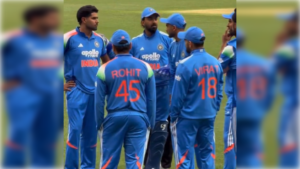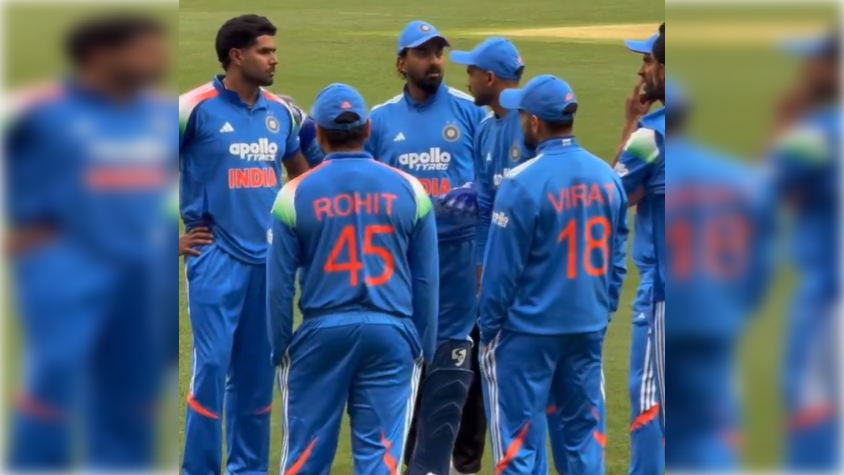
Subhayan Chakraborty in Perth
In a rain-marred first ODI in Perth, on Sunday, India’s much-anticipated return of Rohit Sharma and Virat Kohli ended in disappointment as the team fell short by seven wickets against Australia. The match, reduced to 26 overs per side due to multiple rain interruptions, exposed India’s batting frailties while highlighting the challenges posed by the DLS method. Despite the loss, the presence of Rohit and Kohli reaffirmed their commitment to ODIs, breathing life into a format struggling to maintain relevance.
After an eight-month hiatus following their Champions Trophy triumph in March, Rohit Sharma and Virat Kohli donned India’s ODI kit for the first time since announcing their retirement from Test and T20Is. Their return to Perth was a spectacle, drawing a record crowd for any India versus Australia match, many from Australia’s vibrant Indian diaspora.
Rohit, looking fitter than ever after shedding nearly 10kg, started brightly with a crisp boundary. However, his promising innings was cut short at eight runs by Josh Hazlewood’s probing bounce. Kohli, meanwhile, struggled to adapt to the Perth surface and fell for a duck after a spectacular diving catch by Cooper Connolly off Hazlewood. This marked Kohli’s first ODI duck in Australia and his 39th in international cricket, placing him just behind Zaheer Khan (43) and Ishant Sharma (40) for India.
The early dismissals of Rohit, Kohli, and new skipper Shubman Gill saw India slump to a precarious 25-3, their lowest total at the fall of the third wicket in an ODI featuring the trio. While KL Rahul (38 off 31), Axar Patel (31 off 38) and Nitish Kumar Reddy (19 off 11) staged a recovery to lift India to 136-9, the batting collapse highlighted areas for improvement ahead of the second ODI on October 23 in Adelaide.
Frequent rain interruptions turned the match into a stop-start affair, reducing it from 50 overs to 49, then 35, 32, and finally 26 overs per side. The DLS method, often a contentious factor in rain-affected games, worked against India. After the interruptions, Australia’s target was adjusted to 131, lower than expected for a chasing side in such scenarios. The constant breaks disrupted India’s momentum, particularly after their recovery from 45-4, and handed Australia a manageable chase.
Australia’s victory was as much a result of their aggressive bowling tactics as India’s batting struggles. Captain Mitchell Marsh cleverly exploited the rain-shortened format by frontloading his strike bowlers, Mitchell Starc and Josh Hazlewood. In a 26-over game, ICC rules typically allow four bowlers to bowl five overs each and one to bowl six, with no bowler exceeding 25% of the total overs. However, the frequent rain breaks allowed Australia to maximise their best bowlers.
Starc (6-1-22-1) and Hazlewood (7-2-20-2) bowled 13 overs combined, accounting for 50% of India’s innings. Marsh’s decision to bowl them out early paid dividends. Hazlewood dismissed Shreyas Iyer in his seventh consecutive over after the second rain break, leaving India at 45-4. Starc’s sixth over, bowled immediately after the third interruption, kept India’s scoring in check. This aggressive strategy not only secured key wickets but also ensured a lower DLS-adjusted target, which Australia chased down comfortably with five overs to spare.
Despite the loss, the return of Rohit and Kohli was a win for ODIs, a format increasingly overshadowed by T20s and Test cricket’s resurgence. Their presence drew a massive crowd, a mark of their star power and the excitement they bring. Kohli, widely regarded as the greatest ODI batter of all time, and Rohit, a two-time T20 World Cup champion, are driven by the desire to erase the memory of India’s 2023 World Cup final loss to Australia on home soil. Their commitment to the 2027 World Cup, still two years away, signals their intent to keep ODIs relevant.
Questions linger about their preparation, with some suggesting that playing India A matches against Australia A in Kanpur could have helped them prepare better for the Aussie challenge.. Nonetheless, their mere presence elevates the format’s profile.
India’s batting collapse, particularly the failures of Rohit, Kohli, Iyer and Gill, is a clear area for improvement as they head into the second ODI. The team must adapt to the bounce and pace of Australian pitches while developing strategies to counter rain-affected scenarios and DLS calculations. Notably, early forecasts suggest the Adelaide ODI could also be affected by rain. Australia’s tactical nous, especially in utilising their premier bowlers, serves as a lesson for India’s think tank.
For Rohit and Kohli, the Perth defeat is a minor setback on their road to 2027. As India regroups for the next match, the focus will be on translating their intent into runs and ensuring the demigods of Indian cricket shine brighter in the face of adversity.
Follow Revsportz for latest sports news





